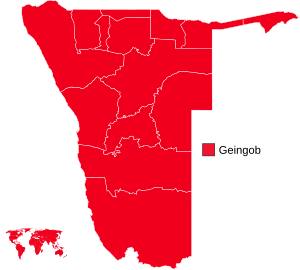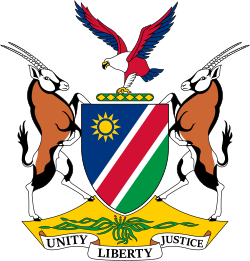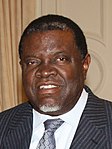2014 Namibian general election
 From Wikipedia - Reading time: 8 min
From Wikipedia - Reading time: 8 min
| |||||||||||||||||
|
| |||||||||||||||||
Presidential election | |||||||||||||||||
| |||||||||||||||||
 Results by region | |||||||||||||||||
| |||||||||||||||||
 |
|---|
General elections were held in Namibia on 28 November 2014, although early voting took place in foreign polling stations and for seagoing personnel on 14 November. The elections were the first on the African continent to use electronic voting.[1][2]
A total of nine candidates ran for the presidency, whilst 16 political parties contested the National Assembly elections. Hage Geingob of the ruling SWAPO party, won the presidential elections with 87% of the vote. SWAPO also won the National Assembly elections, taking 80% of the vote.[3]
Presidential election
[edit]Candidates
[edit]Originally, incumbent President Pohamba predicted that twenty-two candidates would contest the presidential election.[4] In the end, only nine political parties submitted presidential candidates.[5]
SWAPO
[edit]In 2008, the SWAPO Central Committee produced a policy document stating that the party's candidate would be chosen for each election among the top four Committee members. In March 2011 SWAPO declared that whoever was the party's vice-president following the forthcoming party elections would also be the party's candidate in 2014 for president. Some high-level party members, particularly Kazenambo Kazenambo, advocated that SWAPO choose a non-Ovambo candidate, as the first two Presidents, Sam Nujoma and Pohamba, were from the Ovambo people. Others advocated the selection of a woman. SWAPO indicated that the candidate would be chosen democratically in the 2012 party election.[6]
SWAPO was viewed as the clear favorite going into the election.[2]
Parliamentary election
[edit]SWAPO announced a gender equality system where women would fill half of their seats in parliament. The party also embraced what it called a "zebra system", whereby if a minister was a woman, the deputy minister would be a man, and vice versa. Because there were more male SWAPO MPs than female MPs, SWAPO put forward plans to expand parliament to remove the risk of male MPs losing their seats as a result of this gender policy.[7] These changes to the constitution were approved a month prior to the election against the votes of opposition parties, as SWAPO had a two-thirds majority in Parliament.[8] Since then, instead of 78 seats (72 elected, 6 appointed) there 104 seats in the National Assembly (96 elected, 8 appointed).[9]
Results
[edit]President
[edit]| Candidate | Party | Votes | % | |
|---|---|---|---|---|
| Hage Geingob | SWAPO | 772,528 | 86.73 | |
| McHenry Venaani | Democratic Turnhalle Alliance | 44,271 | 4.97 | |
| Hidipo Hamutenya | Rally for Democracy and Progress | 30,197 | 3.39 | |
| Asser Mbai | National Unity Democratic Organisation | 16,740 | 1.88 | |
| Henk Mudge | Republican Party | 8,676 | 0.97 | |
| Ignatius Shixwameni | All People's Party | 7,266 | 0.82 | |
| Usutuaije Maamberua | SWANU | 5,028 | 0.56 | |
| Ben Ulenga | Congress of Democrats | 3,518 | 0.39 | |
| Jan Mukwilongo | Namibian Economic Freedom Fighters | 2,514 | 0.28 | |
| Total | 890,738 | 100.00 | ||
| Registered voters/turnout | 1,241,194 | – | ||
| Source: EISA | ||||
National Assembly
[edit] | |||||
|---|---|---|---|---|---|
| Party | Votes | % | Seats | +/– | |
| SWAPO | 715,026 | 80.01 | 77 | +23 | |
| Democratic Turnhalle Alliance | 42,933 | 4.80 | 5 | +3 | |
| Rally for Democracy and Progress | 31,372 | 3.51 | 3 | –5 | |
| All People's Party | 20,431 | 2.29 | 2 | +1 | |
| United Democratic Front | 18,945 | 2.12 | 2 | 0 | |
| National Unity Democratic Organisation | 17,942 | 2.01 | 2 | 0 | |
| Workers Revolutionary Party | 13,328 | 1.49 | 2 | +2 | |
| SWANU | 6,354 | 0.71 | 1 | 0 | |
| United People's Movement | 6,353 | 0.71 | 1 | New | |
| Republican Party | 6,099 | 0.68 | 1 | 0 | |
| Congress of Democrats | 3,404 | 0.38 | 0 | –1 | |
| Namibian Economic Freedom Fighters | 3,259 | 0.36 | 0 | New | |
| Monitor Action Group | 3,073 | 0.34 | 0 | 0 | |
| Christian Democratic Voice | 2,606 | 0.29 | 0 | New | |
| National Democratic Party | 1,389 | 0.16 | 0 | 0 | |
| Democratic Party of Namibia | 1,131 | 0.13 | 0 | 0 | |
| Appointed members | 8 | +2 | |||
| Total | 893,645 | 100.00 | 104 | +26 | |
| Registered voters/turnout | 1,241,194 | – | |||
| Source: ECN | |||||
References
[edit]- ^ "Namibia to be Africa's first to use e-voting". bdlive.co.za. 15 November 2014. Retrieved 15 November 2014.
- ^ a b Wendell Roelf, "Namibia's ruling party seen winning Africa's first electronic vote", Reuters, 28 November 2014.
- ^ "Publication of results and particulars in respect of general election for election of members of National Assembly: Electoral Act, 2014" (PDF). Government Gazette of the Republic of Namibia. No. 5641. Government of Namibia. 30 December 2014. pp. 3–7.
- ^ "22 Presidential candidates for Namibian election". The Villager. 21 March 2014. Retrieved 25 May 2014.
- ^ "Presidential Candidates: 2014 Elections". Electoral Commission of Namibia. Archived from the original (PDF) on 29 November 2014. Retrieved 15 November 2014.
- ^ Presidential race thrown wide open Archived 31 March 2012 at the Wayback Machine New Era, 14 March 2011
- ^ Namibia's 'zebra' politics could make it stand out from the global herd The Guardian, 8 July 2014
- ^ Iileka, Sakeus (11 November 2019). "Parties aim to break Swapo dominance". The Namibian. p. 1.
- ^ Quadri, Maryam Omolara; Thomas, Erika K (2018). "Women and political participation in Namibia and Nigeria: a comparative analysis of women in elective positions" (PDF). Journal for Studies in Humanities and Social Sciences. 7 (2). University of Namibia: 6–9. ISSN 2026-7215.
 KSF
KSF
